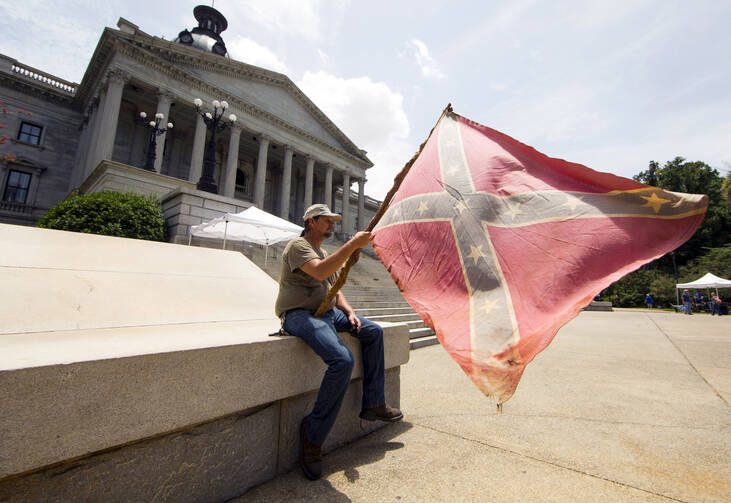As treasurer of the senior class at Grosse Pointe South High School (Class of ’77), right outside Detroit, I spent many a home game in the concession stand, selling hot dogs. My only stab at competing on the field was a brief stint on the track team. At one meet, the referee called for the next event to commence, only to notice a lone straggler—me—still attempting to complete the two-mile run. I desperately wanted a varsity letter that would attest to my adolescent virility, but in those days, they were not awarding letters to members of the debate team.
I did venture into the bleachers often enough to meet with friends. We did a lot of silly things we thought were pretty clever at the time—like hoisting a huge paper-mache bra and calling out for “Support! Support!” of our home team, the Blue Devils. In hindsight, certifiably juvenile, but at the time it seemed edgy, even a little risqué.
This summer I have been recalling another chant that brought us to our feet again and again. To distinguish ourselves from our archrival, Grosse Pointe North, we celebrated our identity as “South” by proudly—and resoundingly—shouting “the South will rise again,” urged on by a cheerleader running across the football field or basketball court with a large Confederate flag. It is jarring in hindsight, but at the time, no one seemed to be bothered. And we were not alone among Northern towns in pressing Confederate paraphernalia into the service of school spirit.
We were not alone among Northern towns in pressing Confederate paraphernalia into the service of school spirit.
If we were ever admonished by a teacher or parent—and I don’t recall that we were—I am sure we would have insisted that it was all in good fun. I know that adults and parents joined in the cheer during games without hesitation.
The Grosse Pointe area was then a segregated enclave of five small cities, totaling almost 60,000 people, with the notorious “point system” designed by real estate agents to keep African-Americans and Jews out. As The New York Times later reported, until the 1960s, “prospective residents were graded on such items as dress and ‘swarthiness,’ and whether or not they were ‘typically American.’” It was shockingly effective: My yearbook confirms that there was not a single Black student in our entire class.
The 17-year-old me would have defended the flag stunt as harmless. The 60-year-old version is a lot less certain. What were all these wealthy white kids doing waving a Confederate flag? We, who boasted one of the best public school systems in the country—including an innovative American studies curriculum—what the hell were we thinking? What message did we send to the opposing teams and communities, some of which were more diverse than ours? And what kind of damage did we inflict on others and ourselves?
What were all these wealthy white kids doing waving a Confederate flag? What message did we send to the opposing teams and communities, some of which were more diverse than ours?
When our basketball team made the playoffs one spring, our opponents included mostly Black teams from Detroit. It was the only time I had seen Black people in our school. I did not have the presence of mind—or frankly, the generosity—to ask myself how they might have heard that chant about the South “rising again.” But it did make me viscerally aware, for the first time that I can remember, of how utterly segregated we were.
Hell, we were just kids. No one meant any harm, right? Maybe so, but that has become an easy excuse for all manner of racial insensitivity, including the use of blackface.
And those times were not so innocent. Amid the pom-pom parties and homecoming parades came a much-anticipated Supreme Court ruling in July 1974 that blocked the cross-district busing intended to alleviate school segregation in metro Detroit. If those white suburbs had not explicitly segregated their schools by law, the justices reasoned, they need not be held responsible for a remedy. Because the “point system” that kept Black families out of Grosse Pointe was nowhere encoded in actual law, we were off the hook.
A sigh of relief went up from Grosse Pointe, one of the several majority-white suburban school districts that joined the suit against the busing program. The landmark 1954 Brown v. Board of Education school desegregation case that we learned about in 9th-grade civics class, a milestone in civil rights law, would not, thankfully, apply to us. We could go on just as we pleased, waving whatever flags we wanted. Busing and desegregation would be Detroit’s problem.
These past few weeks I could not help but think about the myriad ways we have failed to move forward with racial justice in this country. Police brutality is rightly our principal focus now. But culture and upbringing matter as well. And in this area, too, we have to deal with some difficult baggage.
I have done stupider things than cheer to a Confederate flag, that is certain. Today, the greater challenge for me is to balance gratitude for my privileged childhood with the awareness that it was made possible, at least in part, by segregation. We did not create the world of our childhood, but it matters how we remember it.











